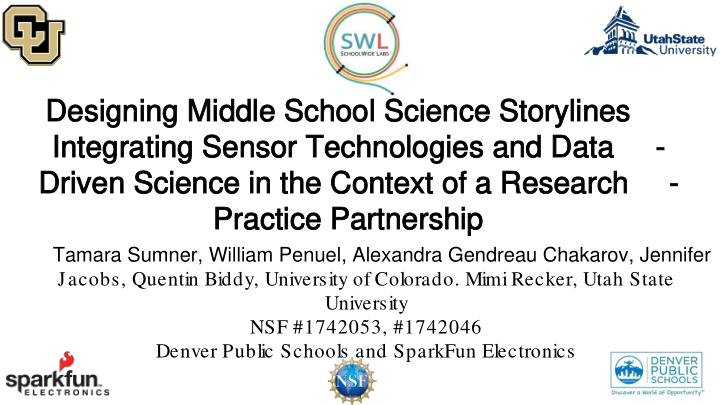



Designing Middle School Science Storylines Designing Middle School Science Storylines Integrating Sensor Technologies and Data Integrating Sensor Technologies and Data - Driven Science in the Context of a Research Driven Science in the Context of a Research - Practice Partnership Practice Partnership Tamara Sumner, William Penuel, Alexandra Gendreau Chakarov, Jennifer Jacobs, Quentin Biddy, University of Colorado. Mimi Recker, Utah State University NSF #1742053, #1742046 Denver Public Schools and SparkFun Electronics 1
Project Goals NGSS+CT (Storyline) curricula NGSS+CT (Storyline) curricula and activities and activities Professional learning Professional learning for teachers and students for teachers and students model to support science model to support science teachers to implement teachers to implement CT CT-Integrated Integrated Sensor technologies for Sensor technologies for middle School science middle School science data data -driven scientific driven scientific lessons lessons investigations about investigations about school and community school and community Broadening Participation in Computational Broadening Participation in Computational Activities through Place Activities through Place -Based Investigations Based Investigations in Mainstream Science Classes in Mainstream Science Classes 2
Professional Learning: Professional Learning: CT Integration Cycle CT Integration Cycle Researchers / teachers Researchers / teachers Researchers / Researchers / learn about learn about teachers reflect on teachers reflect on Co-Design computation and co computation and co - implementation and implementation and design Storylines+C design Storylines+C refine for the next refine for the next lessons lessons design cycle design cycle Reflect Implement Teachers implement Teachers implement Research Research -Practice Practice the Storylines+C using the Storylines+C using Partnership Partnership sensor technologies sensor technologies 3
Project Data Sources Related to supporting teacher learning, participation, and agency: ● Video: ○ Professional Development ○ Classroom Implementation ● Classroom Observations ● Teacher Interviews ● Teacher Perception Surveys Related to supporting student learning: ● Student Experience Exit Tickets (SEETs) (Penuel et al., 2016) ● Student Generated Artifacts ○ (e.g. student developed models & phenomena explanations)
Overarching Findings related to teachers and students ● Storylines are a useful approach to integrate CT, sensor technology, and science in a complimentary way. ● CT integrated science approach helps teachers see value of adding programmable sensor systems to their curriculum and can help students see sensor systems as tools for scientific inquiry. ● Place based investigations of scientific phenomena as well as sensor usage and programming can play a large role to engage students. ● A versatile sensor system supports students’ engagement in CT and Science Practices.
SEETs: What are they? - Student Experience Exit Tickets: Questions used to gauge Coherence, Relevance, and Contribution. - Utilized in other similar research (Penuel et al., 2016) (Penuel et al., 2016) - Administered digitally and/or paper - Used to inform teachers’ instruction and gather research data 1. Today in class I felt like a scientist. (Yes/No) 7. What we did in class today matters to people in my city because: (circle the option that best describes your feelings) 1. Today we used the Driving Question Board (DQB) to review what questions a. This material is important and people should know about it we’ve answered in previous classes. (Yes/No/Not Sure) b. This material could improve the lives of people in my city c. What we did today doesn’t matter to people in my city 1. With the help of our teacher, we used the DQB to guide what we did in class today. (Yes/No/Not Sure) 7. Did you share any ideas out loud today to the whole class, a small group, or a partner? (Yes/No) 1. I understand how what we did in class today ties to the bigger picture for what we’re studying in this unit. (Yes/No/Not Sure) 7. If you answered yes to the last question (9a), did any of your ideas influence the class or help others? (Yes/No) 1. I have ideas about what questions we should investigate next. (Yes/No/Not Sure) 7. Did any other students share ideas out loud today to the whole class, a small 1. What we did in class today matters to me because: (circle one option that best group, or a partner? (Yes/No) describes your feelings) A. This material is interesting 7. If you answered yes to the last question (10a), did you learn more in class B. What we did today will be useful to me in the future today because other students shared their ideas or opinions? (Yes/No) C. What we did today is important to my everyday life and/or people I care about D. It will help me get a good grade E. What we did today doesn’t matter to me
SEETs: Use for Research Ability to look student experiences with learning experiences across: ● Multiple classrooms ○ (e.g. one teacher multiple sections) ○ (e.g. different teachers same storyline unit) ● Compare Storyline Units ○ (e.g. YR1 vs YR2 vs YR3) ○ (e.g. Maglev Unit vs Mold Unit vs Sensor Immersion) ● Demographics ○ Disaggregate ■ Gender Identification ■ Ethnicity ■ Home Language
SEETs: Used to Inform Classroom Instruction Sample SEET Report used during individual and whole group CT-Integrated Storyline Curriculum Implementation Debrief http://bit.ly/YR2MAGLEVSEETDEBRIEF
Thank you! tamara.sumner@colorado.edu quentin.biddy@colorado.edu
Recommend
More recommend